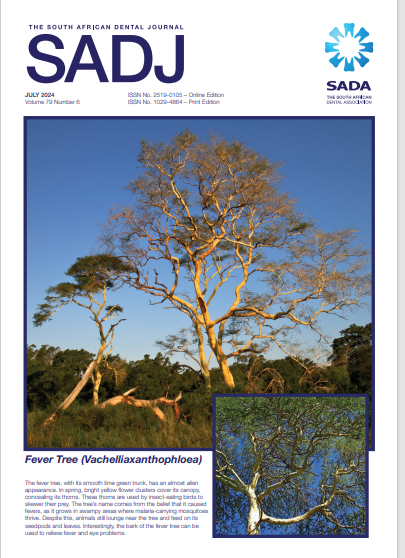Perceived knowledge, treatment approaches and predictors of referral practices in myofascial pain syndrome of the temporomandibular joint
DOI:
https://doi.org/10.17159/sadj.v79i06.17942Keywords:
Dentist, myofascial pain syndrome, trigger points, temporomandibular joint disorders, surveys and questionnaires, referral and consultationAbstract
Myofascial Pain Syndrome (MFPS) of the head and neck is a frequently misdiagnosed cause of Temporomandibular Disorders (TMDs). In South Africa, literature regarding general dental practitioners’ (GDPs) knowledge/management of TMDs associated with MFPS is limited.
Downloads
References
1. Klasser GD, Greene CS. The changing field of temporomandibular disorders: what dentists need to know. Journal of the Canadian Dental Association. 2009;75(1)
2. Bordoni B, Varacallo M. Anatomy, head and neck, temporomandibular joint. 2019
3. Gadotti IC, Hulse C, Vlassov J, Sanders D, Biasotto-Gonzalez DA. Dentists’ awareness of physical therapy in the treatment of temporomandibular disorders: a preliminary study. Pain Research and Management. 2018;2018 DOI: https://doi.org/10.1155/2018/1563716
4. Ghurye S, McMillan R. Pain-related temporomandibular disorder – current perspectives and evidence-based management. Dental update. 2015;42(6):533-46 DOI: https://doi.org/10.12968/denu.2015.42.6.533
5. Valesan LF, Da-Cas CD, Réus JC, Denardin ACS, Garanhani RR, Bonotto D, et al. Prevalence of temporomandibular joint disorders: a systematic review and meta analysis. Clinical Oral Investigations. 2021;25:441-53318 DOI: https://doi.org/10.1007/s00784-020-03710-w
6. Graff-Radford B. Myofascial trigger points: Their importance and diagnosis in the dental office. The Journal of the Dental Association of South Africa = Die Tydskrif van die Tandheelkundige Vereniging van Suid-Afrika. 1984;39(4):249-53
7. Fernández-de-Las-Peñas C, Dommerholt J. International consensus on diagnostic criteria and clinical considerations of myofascial trigger points: a Delphi study. Pain Medicine. 2018;19(1):142-50 DOI: https://doi.org/10.1093/pm/pnx207
8. Sciotti VM, Mittak VL, DiMarco L, Ford LM, Plezbert J, Santipadri E, et al. Clinical precision of myofascial trigger point location in the trapezius muscle. Pain. 2001;93(3):259-66 DOI: https://doi.org/10.1016/S0304-3959(01)00325-6
9. Mora-Relucio R, Núñez-Nagy S, Gallego-Izquierdo T, Rus A, Plaza-Manzano G, Romero-Franco N, et al. Experienced versus inexperienced interexaminer reliability on location and classification of myofascial trigger point palpation to diagnose lateral epicondylalgia: an observational cross-sectional study. Evidence-Based Complementary and Alternative Medicine. 2016;2016 DOI: https://doi.org/10.1155/2016/6059719
10. Ayer WA, Machen JB, Getter L. Survey of myofascial pain-dysfunction syndrome and pathologic bruxing habits among dentists. The Journal of the American Dental Association. 1977;94(4):730-2 DOI: https://doi.org/10.14219/jada.archive.1977.0348
11. Jamalpour MR, Biglarkhany M, Rabiei A, Mirzaei Z. Knowledge and beliefs of general dental practitioners regarding temporomandibular disorders in Sanandaj, Iran. Avicenna Journal of Dental Research. 2011;3(2):86-92
12. Simm W, Guimaraes AS. The teaching of temporomandibular disorders and orofacial pain at undergraduate level in Brazilian dental schools. Journal of Applied Oral Science. 2013;21:518-24 DOI: https://doi.org/10.1590/1679-775720130235
13. Grosman-Rimon L, Clarke H, Chan AK, Mills PB, Rathbone ATL, Kumbhare D. Clinicians’ perspective of the current diagnostic criteria for myofascial pain syndrome. Journal of Back and Musculoskeletal Rehabilitation. 2017;30(3):509-14 DOI: https://doi.org/10.3233/BMR-150380
14. Osiewicz M, Kojat P, Gut M, Kazibudzka Z, Pytko-Polonczyk J. Self-perceived dentists’ knowledge of temporomandibular disorders in Krakow: A pilot study. Pain Research and Management. 2020;2020:1-6 DOI: https://doi.org/10.1155/2020/9531806
15. Alonso AA, Heima M, Lang LA, Teich ST. Dental students’ perceived level of competence in orofacial pain. Journal of Dental Education. 2014;78(10):1379-87 DOI: https://doi.org/10.1002/j.0022-0337.2014.78.10.tb05811.x
16. Alsafi Z, Michelotti A, Ohrbach R, Nilner M, List T. Achieved competences in temporomandibular disorders/orofacial pain: a comparison between two dental schools in Europe. European Journal of Dental Education. 2015;19(3):161-8 DOI: https://doi.org/10.1111/eje.12117
17. Hadlaq E, Khan H, Mubayrik A, Almuflehi N, Mawardi H. Dentists’ knowledge of chronic orofacial pain. Nigerian Journal of Clinical Practice. 2019;22(10):1365-71 DOI: https://doi.org/10.4103/njcp.njcp_110_19
18. Hadlaq EM. Perceived Practitioner Barriers to the Management of Orofacial Pain in the Kingdom of Saudi Arabia: A Cross-sectional Study. The Open Dentistry Journal. 2020;14(1) DOI: https://doi.org/10.2174/1874210602014010520
19. Erdfelder E, Faul F, Buchner A. GPOWER: A general power analysis program. Behavior research methods, instruments, & computers. 1996;28:1-11 DOI: https://doi.org/10.3758/BF03203630
20. Allua S, Thompson CB. Inferential statistics. Air Medical Journal. 2009;28(4):168-71 DOI: https://doi.org/10.1016/j.amj.2009.04.013
21. Taqi M, Mirza AJ, Javed MA, Asghar S, Khadija M, Raza SA. Self-perceived competence of dental students regarding the management of orofacial pain: a cross-sectional study. BMC Oral Health. 2021;21:1-8 DOI: https://doi.org/10.1186/s12903-021-01852-1
22. Rahmeier G, Irineu GL, Maracci LM, Salbego RS, do Nascimento LP, Marquezan M, et al. Avaliação do conhecimento dos estudantes de Odontologia da UFSM sobre DTM e bruxismo. Revista da ABENO. 2021;21(1):1253- DOI: https://doi.org/10.30979/revabeno.v21i1.1253
23. Ziegeler C, Wasiljeff K, May A. Nondental orofacial pain in dental practices –diagnosis, therapy and self-assessment of German dentists and dental students. European Journal of Pain. 2019;23(1):66-71 DOI: https://doi.org/10.1002/ejp.1283
24. Ashwin P, Siri P. Assessment of knowledge, attitude and practice on temporomandibular joint disorders among post-graduate dental students. Int J Dent Res. 2018;3(4):59-62 DOI: https://doi.org/10.31254/dentistry.2018.3207
25. Park JS, Page A, Turner E, Li J, Tennant M, Kruger E. Dental students’ knowledge of and attitudes towards complementary and alternative medicine in Australia – an exploratory study. Complementary Therapies in Medicine. 2020;52:102489 DOI: https://doi.org/10.1016/j.ctim.2020.102489
Downloads
Published
Issue
Section
License

This work is licensed under a Creative Commons Attribution-NonCommercial 4.0 International License.





.png)